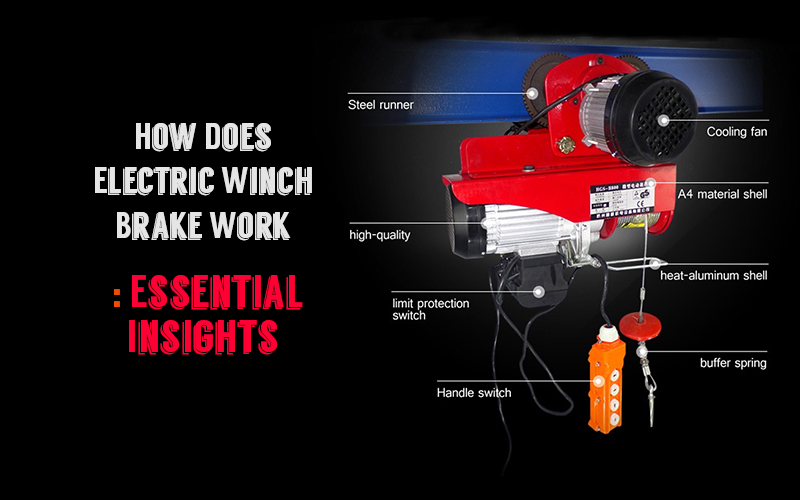How Does Electric Winch Brake Work: Essential Insights

An electric winch brake applies resistance to the winch drum to stop and hold a load. It typically uses electromagnetic or mechanical systems to function.
Electric winches are essential tools for lifting or pulling heavy loads, widely used in industries ranging from construction to marine applications. They operate on the principle of converting electrical energy into mechanical energy to facilitate the movement of objects. The brake system is a critical component of an electric winch, ensuring safety and precision by managing the holding and releasing of the load.
It comes into play once the motor stops, either by cutting power or when the user stops the winch, to prevent the load from slipping back. This safeguard is particularly vital during operations that require maintaining the load in a set position for an extended period or when the winch is not actively pulling. Understanding how the brake mechanism works can be crucial for selecting the right winch for your needs and ensuring the longevity and safety of the device.
Components Of An Electric Winch Brake
Understanding the components of an electric winch brake is crucial for safe operation. These parts work together to control the winch’s movement. Let’s explore the main components.
The Drum
The drum is the part of the winch that winds the cable. It rotates to pull or release the line. The brake is often applied directly to this drum. It ensures that the drum stops turning when the winch is not in use.
The Motor
The motor powers your electric winch. It is the heart of the winch. The motor engages when you control the winch and turns the drum.
The Brake Assembly
The brake assembly is vital for safety. It prevents the drum from spinning back when under load. The brake activates automatically when you stop the winch. This ensures the winch holds its position.
Below is a breakdown of the brake assembly:
- Fricton plates: Engage with the drum to slow it down.
- Spring: Applies pressure to the friction plates.
- Actuator: Releases or applies the brake.
Working Principle Of An Electric Winch Brake
The heart of an electric winch system lies in its brake system. This post explains the process by which an electric winch brake works. Let’s uncover the mystery behind the brake’s engagement and disengagement.
Engagement Of The Brake
Brake engagement happens in halted winching situations. It’s straightforward. Here’s the sequence:
- The operator stops the winch.
- No current flows to the motor.
- A spring pushes on the brake pads.
- The brake pads grip the brake drum.
- The drum cannot rotate; so, it holds the load.
Disengagement Of The Brake
Disengaging a brake is as easy as its engagement. This is how the process unfolds:
- The operator starts the winch.
- Current flows through the motor.
- Motor’s magnetic field overpowers the spring force.
- Brake pads pull away from the drum.
- The drum can rotate and the winch operates.
The ease of using an electric winch lies in its simplicity. The brake forms a key role in helping it operate safely and efficiently. So, knowing how this mechanism works can help in ensuring its longevity and consistent high performance.
Types Of Electric Winch Brakes
Electric winch brakes are integral parts of a winch system. They afford increased safety and control of the load. Let’s explore two common types: Mechanical brakes and Electromagnetic brakes.
Mechanical Brakes
Mechanical brakes utilize physical force to function. Activated manually or mechanically, they retain the load when the power is off. Perfect for frequent starts and stops. They’re known for their simplicity and low-cost maintenance. Here’s how they work:
- The operator applies force directly to the brake.
- Force transfers to the brake pads.
- The pads grip the winch drum, preventing movement.
This simple, yet effective design is popular due to its reliability.
Electromagnetic Brakes
Electromagnetic brakes stop motion using magnetic force. They are more sophisticated and offer greater precision than mechanical models. When the current flows, the brake is released. When the power is off, the brake engages. This process follows these steps:
- Electric current generates an electromagnetic field.
- This magnetic force attracts the brake shoes to the drum.
- As a result, the winch halts immediately.
Electromagnetic brakes are ideal for applications needing highly accurate braking.
Frequently Asked Questions On How Does Electric Winch Brake Work
Do Electric Winches Have Brakes?
Yes, most electric winches are equipped with brakes to securely hold loads when not actively winching. These brakes prevent the load from slipping or unwinding under tension.
How Does A Self Braking Winch Work?
A self-braking winch integrates an automatic brake system that engages when the winching operation halts. This brake prevents the load from slipping or rolling back, ensuring the load remains stationary and secure when the winch is not actively pulling.
What Is The Braking System In A Winch?
The braking system in a winch ensures safe, controlled descent and stops. It often features mechanical, automatic, self-locking brakes to prevent winch from accidentally releasing load. This system is crucial for equipment safety.
How Does The Brake Work On A Warn Winch?
A Warn winch brake works by automatically holding the load when the operator stops winching. It uses mechanical friction to prevent the reel from unwinding. It enables safe and controlled load management while winching.
Conclusion
Now you have vivid insight into how an electric winch brake functions. This understanding aids not only in effective usage but also in ensuring safety. Keep in mind, a well-maintained brake system increases the lifespan of your winch. Always prioritize routine checks and maintenance.
Remember, knowledge is power when it comes to operating machinery efficiently and safely.
